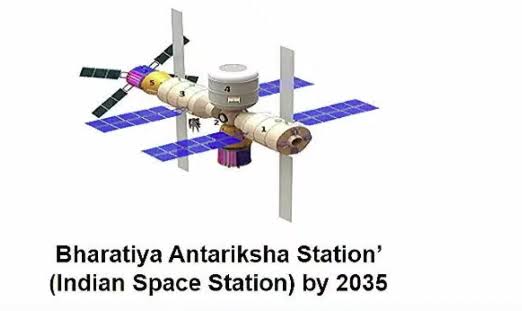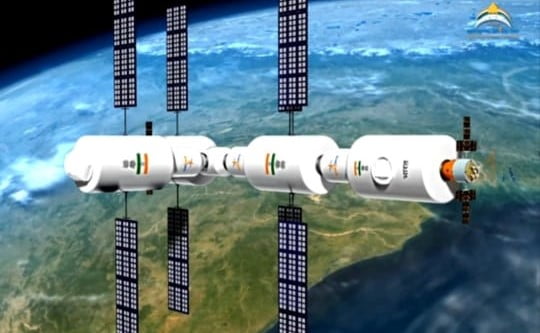Indian Space Research Organisation (ISRO) is planning to launch the first module of the Indian Space Station which is named “Bhartiya Space Station (BAS)” in 2028. After the inauguration of this space station, India will join the ranks of countries with their space stations, placing it as the fourth nation globally to achieve this feat, following Russia, the United States of America, and China.
Back in 1971, Russia made history by launching the world’s first space station, Salyut 1. Fast forward to today, both the USA and Russia are collaborating as part of the International Space Station. Meanwhile, China entered the space station club by launching its Tiangong-1, in 2011.
Indian Space Station
The Indian Space Research Organisation (ISRO) is excited about establishing the “Bhartiya Antariksh Station (BAS)” by 2035. This space station will have two key modules in addition to its 5 modules: the first module, a robotic arm space capsule, and the second module, an inflatable habitat. The entire weight of the Indian Space Station is estimated to be around 52 tons. They plan to launch the first module in 2028, and the station will be ready for humans to live in after 2035. The station is designed to accommodate at least 3 to 4 astronauts at a time in normal conditions and around 6 astronauts for short duration.

The first module of the Bhartiya Space Station will be an 8-ton artificial intelligence robotic arm space capsule designed for research and development and it is scheduled to be launched by the LVM-3 rocket in 2028.
Currently, ISRO doesn’t have a powerful rocket. The most robust rocket in its fleet is the LVM 3 rocket, which can only carry a payload of 10 tonnes. Due to this limitation, ISRO has opted for an 8-tonne payload for the first module.
ISRO is working on a new rocket called the “Next Generation Launch Vehicle” (NGLV). This rocket will be responsible for launching additional modules of the Indian Space Station, and these upcoming modules are expected to be larger, weighing approximately 20 to 25 tonnes. These larger modules cannot be launched using the existing rocket.
You can get more information about NGLV on NGLV: Next Generation Rocket for India’s Space Station by 2035
ISRO is also developing a human-rated Next Generation Launch Vehicle (NGLV) to transport astronauts to the space station, and lunar orbit, and facilitate docking with the Artemis lunar base.
In 2024, ISRO plans to launch the SPADEX (Space Docking Experiment ) mission to lay down the foundation of the Indian Space Station. Docking is like joining two spacecraft together in space. They can do this to move people or cargo from one spacecraft to another when two independent spacecraft join together to create a larger, unified structure. A great example of docking is when a cargo spaceship links up with the International Space Station (ISS). ISRO is developing this technology indigenously.
You can get more details about Spadex on SPADEX – India’s Space Station by 2035
Detailed Specification Indian Space Station
| Name | Bhartiya Antariksh Station (BAS) |
| Number of modules | 5 |
| 1st module | launch by LVM 3 in 2028 |
| Weight of 1st module | 8 Tonne* |
| 2nd module | Inflatable habitat module* |
| Total weight in 1st phase | 20 to 25 Tonne* |
| Total Mass | 52 Tonn |
| Orbit | Lower Earth Orbit (400-450 km), 51.5 degree |
| Completion | 2035 |
Overall Configuration of Indian Space Station

| Modules | Envelope, m | Mass Kg | Launch Vehicle | |
| 1 | Base Module | 3.8 dia x 8.00 | 9186 | LVM3 |
| 2 | Core Module | 3.8 dia x 9.25 | 10033 | LVM3 |
| 3 | Science Module | 3.8 dia x 9.25 | 10896 | LVM3-SC |
| 4 | Lab Module | 3.8 dia x 9.25 | 10646 | LVM3-SC |
| 5 | CBM Module | 3.8 dia x 9.25 | 10969 | LVM3-SC |
Application of Indian Space Station
(1) Study of microgravity
(2) Space biology and space medicine research
(3) Gateway to Deep Space Exploration
(4) Refueling Station for Lunar, Martian, and Venusian Exploration
Facts of International Space Station
The International Space Station measures 109 meters from end to end and boasts a volume equivalent to two Boeing 747 jets, making it almost as spacious as a full-length American football field. Within its confines, approximately 13 kilometers of wiring intricately connect the entire electric circuit system, facilitating the station’s operations. Notably, about one-third of the station is allocated for storage and equipment, while the remaining space is crafted for human habitation for a crew of six and some visitors.

